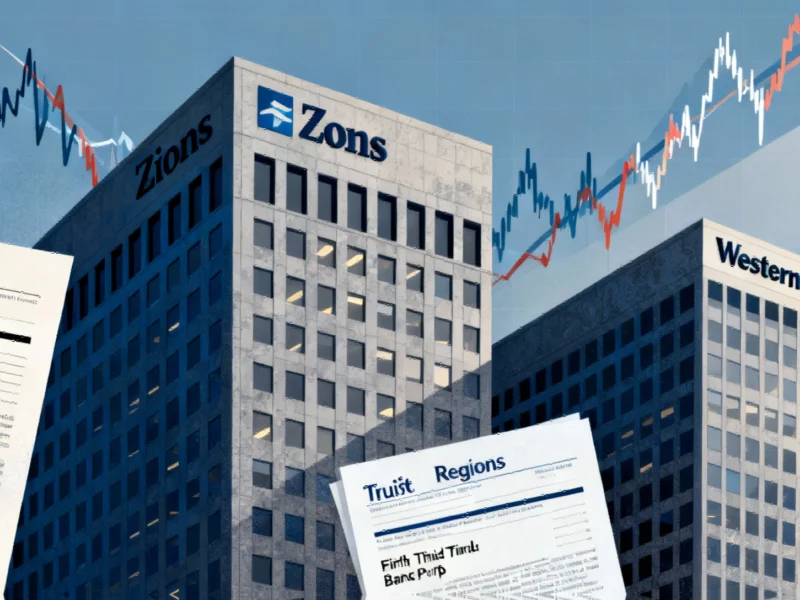The Banking Sector’s Warning Shot
Last week’s sudden plunge in regional bank stocks served as a stark reminder that market risks often emerge from unexpected corners. While initial fears centered on specific lending issues at Zions Bancorp and Western Alliance, the episode revealed deeper concerns about credit quality spreading through financial markets. Unlike previous volatility driven by technology sector corrections, this scare originated in the fundamental lending ecosystem that underpins corporate America.
Zions Bancorp’s disclosure of a $50 million charge-off on a subsidiary loan and Western Alliance’s fraud lawsuit against a borrower triggered a chain reaction that briefly sent markets reeling. Though both stocks recovered somewhat by Friday, the incident highlighted how quickly credit concerns can translate into broader market volatility. The banking sector’s interconnectedness means that isolated credit issues can rapidly become systemic concerns, as evidenced by recent banking sector volatility linked to credit conditions.
The Private Credit Conundrum
JPMorgan CEO Jamie Dimon’s “cockroach” analogy points to a larger issue brewing beneath surface-level market calm. The recent bankruptcies of Tricolor Holdings and First Brands have exposed vulnerabilities in the rapidly expanding private credit market—a $1.5 trillion ecosystem of non-bank lenders including private equity firms, hedge funds, and specialty finance companies. These lenders typically serve businesses that might struggle to secure traditional bank financing, but this specialization comes with unique risks.
“When banks are forced to stretch for yield in uncertain economic cycles, it exposes the cracks in conventional risk models,” noted Frank Scarso of Avanza Capital Holdings. This dynamic becomes particularly concerning given that major banks continue to be significant funders to these non-bank lenders, creating an interlinked risk web that extends throughout the financial system. Recent global economic resilience has paradoxically enabled continued expansion in these potentially risky lending channels.
Transparency Troubles in Shadow Banking
The core concern with private credit lies in its opacity. Unlike publicly traded corporate bonds or bank loans, private credit arrangements often lack standardized reporting requirements and trade in less liquid markets. Marcus Sturdivant Sr. of advisory firm The ABC Squared describes the situation as “a reflection on the fog involved with private credit and equities,” where limited visibility makes accurate risk assessment challenging.
This lack of transparency compounds other issues, including potential erosion of underwriting standards as lenders compete for business in a crowded field. While technological advancements in recent technology platforms have improved some monitoring capabilities, the private credit market remains significantly less transparent than traditional banking channels.
Diverging Expert Perspectives
Market professionals remain divided on the severity of the private credit threat. The optimistic view, articulated by economist Ed Yardeni, suggests that losses in private credit markets primarily affect specific investor returns rather than triggering economy-wide credit crunches. This perspective finds some support from Moody’s, whose private credit head Marc Pinto noted they’ve yet to see concrete evidence of a fundamental credit cycle turn.
However, the cautious camp points to structural vulnerabilities. As major industrial players like Schneider Electric continue expanding operations, their financing needs increasingly touch both traditional and private credit markets. Similarly, government initiatives such as the UK’s AgriScale program demonstrate how public and private financing intersect in modern economic development.
Navigating the New Credit Landscape
For investors and corporate treasurers, the recent bank volatility offers several important lessons. First, credit risk monitoring must extend beyond traditional banking metrics to include the sprawling private credit ecosystem. Second, the interconnections between bank and non-bank lending require more sophisticated risk modeling that accounts for second-order effects.
Most importantly, market participants should recognize that today’s credit environment differs substantially from previous cycles. The growth of private credit has created both opportunities and vulnerabilities that demand updated analytical frameworks. As competition intensifies and market trends evolve, the ability to distinguish between isolated incidents and systemic threats will separate successful market navigation from reactive panic.
The path forward requires balanced vigilance—acknowledging real risks without overreacting to temporary volatility. As last week’s events demonstrated, markets can recover quickly from credit scares, but the underlying issues prompting those scares often persist long after prices have stabilized.
This article aggregates information from publicly available sources. All trademarks and copyrights belong to their respective owners.



